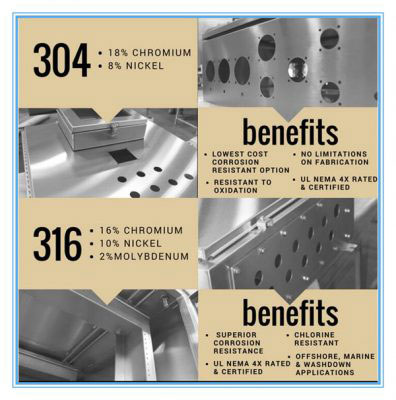What’s the difference–304 VS 316 Stainless Steel?
304 and 316 stainless steel are the two of the most widely used stainless steel casting grades in the world. Both of them have excellent corrosion resistance and value.
304 stainless steel contains between 16 and 24 % chromium, as well as small amounts of carbon and manganese. The most common form is 18-8 (18/8) stainless steel. It contains 18 percent chromium and 8 percent nickel. 316 grade has almost the same physical and mechanical properties as 304 stainless steel. The key difference is that 316 stainless steel incorporates about 2 to 3 % molybdenum. The addition increases corrosion resistance, particularly against chlorides and other industrial solvents.
For 304 vs 316 stainless steel, there is no such definition of “which is good”. Because different stainless steel materials have different uses. Today, let’s The difference between 304 VS 316 stainless steel is as below.
1– 304 vs 316 stainless steel Chemical composition difference:
| Grade | 304 | 316 |
| C | 0.08 % Max | 0.08 % Max |
| Si | 1.00 % Max | 1.00 % Max |
| Mn | 2.00 % Max | 2.00 % Max |
| P | 0.045 % Max | 0.045 % Max |
| S | 0.015 % | 0.015 % |
| N | 0.10 % | 0.10 % |
| Cr | 18.00-20.00% | 16.00-18.00 |
| Ni | 8.00-10.50 % | 10.00-14.00% |
| Mo | – | 2.00-3.00% |
From the table, we can see that the Biggest difference between 304 vs 316 stainless steel is that stainless steel 306 has 2-3 more nickel than 304 stainless steel. This helps resist corrosion to chlorides (like seawater and de-icing salts).
Alternative 300-series grades can contain up to 7 percent molybdenum. They provide even better chloride resistance. But such heavy-duty resistance is only necessary for industrial or high concentration exposure conditions.

2. 304 vs 316 stainless steel Properties difference
304 stainless steel is the most common steel grade. As a kind of widely used metal, it has good corrosion resistance, heat resistance, low-temperature strength, and mechanical properties. Good hot workability such as stamping and bending. No heat treatment hardening phenomenon (no magnetic, use temperature -196 ° C ~ 800 ° C).
316 stainless steel is particularly good in corrosion resistance, atmospheric corrosion resistance, and high-temperature strength due to the addition of molybdenum. Can be used under harsh conditions. Excellent work hardenability (non-magnetic).
3. 304 vs 316 stainless steel Applications difference
304 Application Scopes
- Kitchen fittings like sinks and splashbacks, saucepans, flatware, tableware, cabinets,
- kitchen appliances like refrigerators and dishwashers,
- Household items of indoor pipelines, water heaters, boilers, bathtubs
- Heat exchangers,
- Commercial food processing equipment, making brewery, pharmaceutical production equipment
- Making nuts, bolts, screws, and nuts
- Water piping, Storage tanks, Indoor electrical enclosuresAutomotive trim
- Decorative trim
316 Application Scopes
- Chemical piping
- Pharmaceutical equipment
- Medical equipment and tools
- Stainless steel floats
- Structural steel and components in marine environments
- Making food, chemical and petrol production and processing equipment
- Construction of laboratory benches and equipment
- Architectural paneling in the coastal region
- Marine HardwareTubing
4. 304 vs 316 stainless steel Corrosion resistance Differences
Between 304 vs 316 stainless steel, stainless steel 316 has better corrosion resistance than 304 stainless steel. Good corrosion resistance in the production of pulp and paper. Moreover, 316 stainless steel is also resistant to erosion by marine and aggressive industrial atmospheres.
In general, 304 vs 316 stainless steel has little difference in chemical resistance. But, there are differences in certain media.
The stainless steel originally developed was 304. In certain cases, this material is sensitive to pitting corrosion (PittingCorrosion). An extra 2-3% increase in molybdenum can reduce this sensitivity. This gave birth to 316. Also, this extra molybdenum can also reduce the corrosion of certain hot organic acids.
316 stainless steel has almost become the standard material for the food and beverage industry. Due to the shortage of molybdenum in the world and the nickel content in 316 stainless steel. The price of 316 stainless steel is more expensive than 304 stainless steel.
Pitting corrosion is a phenomenon mainly caused by deposition corrosion on stainless steel surfaces. This is because oxygen deficiency does not form a chromium oxide protective layer.
Especially in small valves, the possibility of deposits on the valve plate is small. Thus, pitting corrosion is also rare.
Among various types of water media (distilled water, drinking water, river water, boiler water, seawater, etc.). 304 stainless steel and 316 stainless steel have almost the same corrosion resistance. Unless the chloride ion content of the medium is very high. Now, 316 stainless steel is more suitable.
In most cases, the corrosion resistance of 304 vs 316 stainless steel is not much different. But in some cases, it can also vary a lot. Specific analysis is required.
In general, valve users should be aware of it. Because they choose the material of the container and the pipe according to the condition of the medium. It is not recommended to recommend materials to users.
5.Heat resistance
316 stainless steel has good oxidation resistance in intermittent use below 1600 °C and continuous use below 1700 °C. In the range of 800-1575 degrees, 316 stainless steel can not be continuous.
When 316 stainless steel is continuously used outside this temperature range, it has good heat resistance. Extra-low carbon stainless steel 316L has better carbide precipitation resistance than SS316. It can be used in the above temperature range.
6.Heat treatment
The annealing process of Heat treatment is carried out at a temperature ranging from 1850 to 2050 degrees. Then followed by rapid annealing and rapid cooling. 316 stainless steel cannot be hardened by heat treatment.
7.Welding
Between 304 vs 316 stainless steel, 316 stainless steel has good welding properties. All standard welding methods can be used for welding.
When welding, 316Cb, 316L, or 309Cb stainless steel filler rods or welding rods can be used for welding according to the application.
For best corrosion resistance, the SS316 welded part requires post-weld annealing. If 316L stainless steel is used, post-weld annealing is not required.
8. Cost Difference
The cost of stainless steel is largely dependent on the composition of the alloy.
All stainless steels require a minimum of 10.5% chromium. And they are alloyed with iron. The various other elements present though have an impact on the properties and characteristics and ultimately, cost.
316 contains a minimum of 2.0% molybdenum. It makes it much more corrosion-resistant than 304 stainless steel. Molybdenum is a more expensive element, generally, it makes 316 a more expensive grade of metal.
9. Mechanical
Among all steels, austenitic stainless steel has the lowest yield point. So for mechanical properties, austenitic stainless steel is not the best material for the valve stem. Because of the certain strength, the diameter of the stem will increase. The yield point cannot be increased by heat treatment but can be improved by cold forming.
| Item | 304 | 316 |
| Yield strength (N/mm2) | ≥205 | ≥175 |
| Tensile strength | ≥520 | ≥480 |
| Elongation (%) | ≥40 | ≥40 |
| Hardness | HB ≤187, HRB≤90, HV ≤200 | HB≤187, HRB≤90, HV≤200 |
| Density | 7.93g/cm3 | 7.87g/cm3 |
| Thermal conductivity λ/W(m·℃)-1 (at the following temperature/℃) | 20,100,500 | 100 300 500 |
| _ | 12.1,16.3,21.4 | 15.1 18.4 20.9 |
| Linear expansion coefficient α/(10-6/℃) (between the following temperatures/℃) | 20~100,20~200, 20~300, 20~400 | 20~100 20~200 20~300 20~400 20~500 |
| _ | 16.0, 16.8,17.5, 18.1 | 16.0 17.0 17.5 17.8 18.0 |
| Resistivity | 0.73 Ω·mm2/m | 0.71Ω·mm2/m |
| Melting point: | 1398~1420℃ | 1371~1398℃ |
10. Magnetic
Due to austenitic stainless steel wide application, it gives people the wrong impression that all stainless steels are not magnetic. For austenitic stainless steel, it can be basically understood as non-magnetic. Because it is the case with quenched forged steel. But the 304 processed by cold forming will be somewhat magnetic. For cast steel, if it is 100% austenitic stainless steel, it is not magnetic.
11. Low carbon types
The austenitic stainless steel corrosion resistance comes is from the chromium oxide protective layer formed on the metal surface. If the material is heated to a temperature between 450 ° C and 900 ° C. The structure of the material changes and chromium carbide forms along the edges of the crystal. Thus, a chromium oxide protective layer cannot be formed at the edge of the crystal, resulting in a decrease in corrosion resistance. This type of corrosion is called “intergranular corrosion.”
304L stainless steel and 316L stainless steel were developed to combat this corrosion. Both 304L stainless steel and 316L stainless steel have lower carbon content. Since the carbon content is reduced, chromium carbide is not produced and intergranular corrosion is not generated.
It should be noted that higher intergranular corrosion sensitivity does not mean that non-low carbon materials are more susceptible to corrosion. This sensitivity is also higher in high chlorine environments.
Please note: This phenomenon is due to high temperatures (450 ° C – 900 ° C). Usually soldering is the direct cause of reaching this temperature. For soft seat conventional butterfly valves, the use of low carbon stainless steel does not make much sense since we do not weld on the valve plate. But, most specifications will need 304L stainless steel or 316L stainless steel.
If you want to learn more of 304 VS 316 Stainless Steel, watch the videos, please!
We are a professional stainless steel investment casting foundry in China with 20+ years of history. We take different grades or types of stainless steel, alloy steel as precision casting raw materials.
We can make all types of stainless steel castings, not only limited to 304 and 316 but can also make stainless steel investment castings with other grades. Such as PH17-4, CG8M, 2205, etc. Any project or product about stainless steel casting. Kindly contact us for more details.
